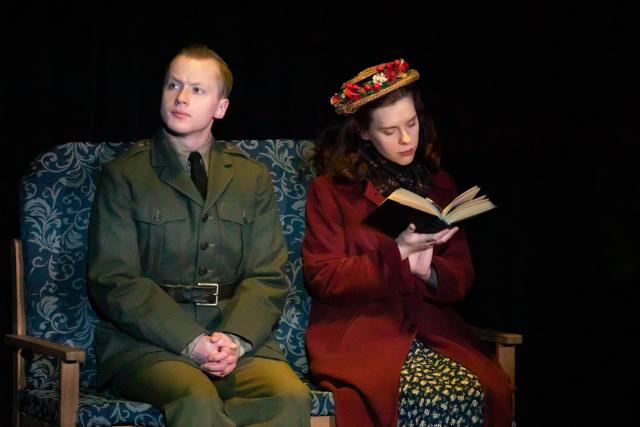
Acacia Theater, Milwaukee’s Christian faith-based theater company, presents a tiny gem of a play in Arlene Hutton’s Last Train to Nibroc. Set in late December in 1940, the tale begins as two strangers are seated together on a crowded eastbound train from Los Angeles. He is Raleigh, a washed-out serviceman (still in uniform) who dreams of visiting the bright lights of New York City. She is May, clever and sweet, who is returning home from a Christmas visit to her serviceman boyfriend that did not end well.
Both of these emotionally fragile characters have already felt the sting of cultural changes surrounding World War II. May remarks bitterly that she can’t believe how much her now-former boyfriend “has changed” since he joined the Army. Raleigh discovers at boot camp that a previously undiagnosed physical condition has caused him to be discharged from the Army. He, too, is bitter that his “buddies” will go to war without him. He feels as though he has let them down.
One thing leads to another as the train rolls on, and the young couple learn that they are from neighboring towns in Kentucky. Raleigh is a farmer, and May is just finishing her elementary education degree. (Her town, Corbin, KY, exists in real life. Likewise, the town’s famed annual event, the Nibroc Festival (Nibroc is Corbin spelled backwards) is also a real festival.)
May has never attended the festival, she tells Raleigh, because it concurs with a series of religious tent meetings in the area. She assumes that it wouldn’t be a proper place for her, anyway, since who knows what deviltry is practiced there? Raleigh is astonished at her ignorance of this long-standing festival, which he says is “just another party.” He vows to take her there someday.
While the pair is drawn together by age and geography, they differ widely in their beliefs. Raleigh (who also considers himself a religious man) is tempted to poke fun at May. This even includes the reading material she takes on the train. She is surprised that Raleigh is familiar with her book, which she has borrowed from the church library. Raleigh teases May about being more interested in the book’s romantic aspects than in its Christian principles.
The play also takes a clear-eyed look at the changing roles of women during World War II. Almost as soon as May graduates from college, she is assigned to a classroom and soon becomes principal of the whole school. May expresses astonishment at her quick rise to the top (despite the fact she clearly has the brains and organizational skills necessary for running the school.)
Although readers probably never have heard of this play or its playwright, Last Train to Nibroc has been produced more than 100 times since 1999. Productions have been staged in Cincinnati (Cincinnati Playhouse), Off-Broadway in New York, Ventura, CA (Rubicon Theatre Company), Dallas (Echo Theater) and Chicago (Theater Wit). The Chicago Tribune critic called it a “a surprise summer don’t-miss.” Hutton’s play has been compared to stories by Pulitzer Prize-winning William Inge, and filmmaker John Huston. It was nominated for Best Play 2000 by the New York Drama League.
Acacia Theater’s production is a Milwaukee premiere, and its short run will be a disappointment to patrons who will miss it. Perhaps the theater company should consider extending its current run, or staging a revival sometime in the future. It’s a simple two-hander that requires only a bench and a few props to execute. It has found a perfect home in the basement of an Episcopal Church in River Hills, an affluent suburb just outside of Milwaukee. By its design, the dark, intimate theater space draws one’s attention to the stage. Audience members are within spitting distance of the onstage action, and this creates a more intense experience than one would find in a proscenium setting.
As Raleigh and May, AJ Magoon and Maura Atwood create an undeniable chemistry. Even when their characters are squabbling (which is often), one senses that their tiffs will be short-lived. May’s hilarious misunderstanding about the nature of Raleigh’s affliction makes the play’s final scenes laugh-out-loud funny, but there is also a subtle current of humor throughout the play.
As far as the play’s Christian aspects, it is Raleigh who gets May to reconsider some of her strict, church-endorsed views. He bluntly tells her that some of her leanings don’t represent Christian values at all. He would like to see her soften and forgive those who fail and deserve a second chance. May sometimes bristles at this advice, but later she admits that she does take his words to heart.
There is something so cute, so endearing and so loveable about these characters that one almost hates to leave them at the end of the play. The good news is that Arlene Hutton’s play is part of a trilogy. Although Last Train to Nibroc is her most-produced play, there are other chapters to this story contained in the rest of the trilogy.
Older audience members who actually experienced World War II will find familiar territory here. They will probably get the most enjoyment out of this fine production.
The play’s technical aspects – especially the sound design – help flesh out the respective scenes. During the train ride, for instance, one can hear the constant chugging of a locomotive. Later, when Raleigh actually convinces May to attend the Nibroc Festival, the sounds of laughing kids and carnival music is heard (sound design by Colin Kovarik). The couple’s clothes, which change intermittently during the 90-minute, intermission-less play, seem to have traveled through space and time from poverty-stricken days in the old South (costumes by Katlyn Rogers Kelly). The set (by Ashley Petrowsky) consists of little more than a bench and a street lamp, but they are enough for this small stage. Lighting (by Dan Hummel) is adequate, considering the facility’s lack of fancy stage lights.
